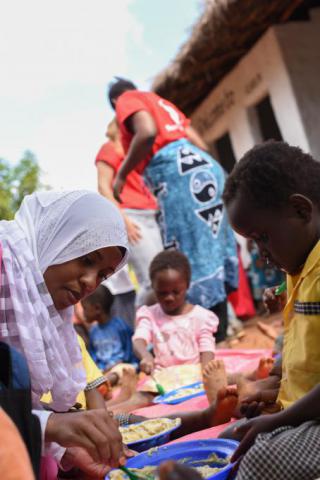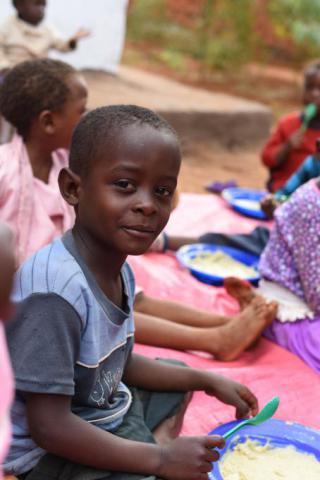Improving Child Nutrition and Development in Southern Malawi: One Meal at a Time

Photo: Luzayo Nyirongo, Save the Children.
Malawi has had a long history of poor child nutrition, which has stunted the growth and development of around 47% of children aged 6 to 59 months. Poor nutrition, after all, has severe long-term health effects on children, including, but not limited to, developmental delays, stunted height, and memory deficiencies. Malnutrition and micronutrient deficiencies are common in Malawi because of food insecurity, low agricultural production due to the lack of rainfall, and the excessive burdens of poverty. To help combat these issues in children, PATH supports IFPRI‘s evaluation study being implemented by Save the Children in Zomba District in the Southern Region of Malawi, which works to improve agricultural and nutrition practices in homes and families. To prevent slow development in children, which is a common effect of malnutrition, Save the Children and their early childhood development (ECD) program aim to provide nutritious food and learning environments to children and families in community-based childcare centers (CBCCs), serving around 40% of 3- to 5-year-olds in Malawi.
With thousands of CBCCs spread across the country, this project works to increase community and parental involvement by creating wholesome environments with access to health and nutrition services for children and intends to leave a lasting effect on the behaviors and practices of the families that participate.

Photo: Luzayo Nyirongo, Save the Children.
PATH spoke to Aisha Twalibu, the NEEP research coordinator in Malawi. She discussed the NEEP study’s progress to date and mentioned that one of the main reasons the project is thriving is because it is aimed toward improving practices and behaviors not only in the CBCCs, but also in people’s households and daily lives. For instance, nutritious meals are cooked and provided in the CBCCs, which are then replicated by parents in their own homes. Parents learn how to cook healthy, easy meals that are loaded with nutrients and can thereby keep their children’s nutrient intake consistent by making the meals often at home. Aisha discussed food insecurity in the CBCCs as a problem that has resulted in a decreased attendance rate, because often it is hard to provide daily meals, such as porridge. However, one of the goals of the project is to give people the tools and skills they need to produce food independently, so that households can contribute by producing the food that is distributed at CCBCs. The program appears to be a success because of just that: its sustainability.
Because approximately 91% of the population in Malawi lives in rural areas, farming is an essential aspect of people’s livelihoods. This project focuses heavily on agricultural interventions. Particularly, agricultural extension and development officers (AEDOs) train households/farmers to plant and harvest seeds and vegetables such as sweet potatoes, which are particularly useful for boosting nutrition: they are a great source of vitamins A and C and have edible leaves. According to Aisha, one of the most successful parts of the project so far is farming and crop-tending because of how beneficial they are to families for food production. Farmers are taught how to harvest crops in accordance with the rainfall, which is necessary for healthy crops. Aisha discussed a lack of rainfall being one of the biggest challenges of the project, and how it sometimes slowed down the harvesting process. Because rainfall is so unpredictable in Malawi, especially in recent years, food storage and preservation is crucial, so Save the Children also focuses on teaching people how to store different types of foods.

Photo: Luzayo Nyirongo, Save the Children.
Another life-changing intervention that the project introduced is that of nutrition and hygiene, particularly regarding meal preparation. CBCC management committees, caregivers, and parents were trained to prepare meals that included food from all the different food groups, to wash their hands properly before cooking and before eating, and to instill these practices in children, both at the CBCCs and at home. It is expected that these practices will eventually become routine, and as a result, nutrition and hygiene can become embedded in daily life.
Early indicators of the project show a significant amount of success and progress because of its long-term vision; rather than simply providing information to an audience, this project combines informative teaching and hands-on activities to give families the most out of the resources they have and to equip them with skills, practices, and values that will last a lifetime.
Sources:
http://www.unicef.org/malawi/children.html
http://borgenproject.org/child-malnutrition-malawi/
https://www.usaid.gov/sites/default/files/documents/1864/USAID-Malawi-Profile.pdf
Article by PATH intern Sara Mannan.
For more information, please contact neep@path.org.
The original article can be found at: http://sites.path.org/mchn/2016/08/improving-child-nutrition-and-develop...
 Malawi
Malawi